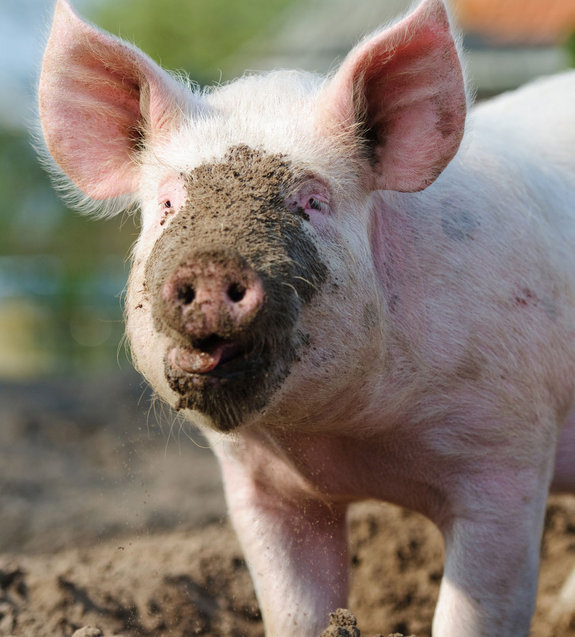Antibiotics Breed Drug-Resistant Bacteria in Pigs

After giving pigs a low-dose of antibiotics for just two weeks, researchers detected a drastic rise in the number of E. coli bacteria in the guts of the animals. And those bacteria showed a large jump in resistance to antibiotics.
The particular strain of E. coli detected in the study was not pathogenic to pigs or humans. But the results add to concerns that regular use of antibiotics in farm animals could spread dangerous and drug-resistant varieties of bacteria throughout the environment and into our food and water.
The new findings also emphasize the need to find ways to keep animals healthy without antibiotics.
"We wouldn't have been surprised that bacteria shift populations or that resistance genes changed," said Thad Stanton, a microbiologist at the USDA Agricultural Research Service's National Animal Disease Center in Ames, Iowa. "We were a little surprised by how much E. coli populations went up in the medicated group. We were so surprised that we did a repeat experiment in culture. And the number went up by 20 to 100-fold. That's a big change."
"We have to be judicious in antibiotic use," he added. "We are going to need to work together on this, and we need research to discover alternatives."
Regular doses of antibiotics are the most effective and efficient way to maintain the health and growth of farm animals, and use of the drugs has become standard practice on conventional farms over the last 50 years.
But studies have long shown that antibiotic use leads to an increase in antibiotic resistance in animals taking the drugs as well as in people working on the farms where those animals live. Even when farmers stop using the drugs, resistance persists for years, as mothers pass their drug-resistant flora down to their offspring for generations.
Sign up for the Live Science daily newsletter now
Get the world’s most fascinating discoveries delivered straight to your inbox.
Because animals shed their gut bacteria through their feces, which often get spread all over fields, antibiotic use in agriculture has raised worries about the spread of untreatable epidemics throughout the human population. The FDA is currently changing the way it regulates the practice.
NEWS: Ancient Nubians Drank Antibiotic-Laced Beer
To see exactly what happens inside the guts of animals receiving antibiotics, Stanton and colleagues started with female pigs that had never been exposed to antibiotics. In their sterile lab, the researchers allowed the sows to deliver piglets. When weaning was complete, they divided the little pigs into two groups.
In their daily chow, six of the pigs received a low dose of a product called ASP250, which contains three antibiotics and is commonly used for treating several pig diseases and for enhancing growth and performance. The other group ate the same kind of food but was unmedicated. For three weeks, researchers collected pig poop and used the newest, most advanced technologies available to analyze gut bacteria in the feces.
Within two weeks, the researchers report today in the Proceedings of the National Academy of Sciences, the proportion of a group of bacteria called Proteobacteria had increased from one percent to 11 percent in the poop of the medicated pigs. E. coli accounted for the majority of that rise.
NEWS: Drug-Resistant Gonorrhea Strain Emerges
Bacteria in both medicated and non-medicated pigs held multiple genes that conferred resistance to antibiotics, according to DNA analyses. But treatment with antibiotics produced a detectable rise in resistance, and not just to the drugs the pigs were eating. Genes also flourished that could resist other kinds of antibiotics as well, and researchers are now puzzling over the details of how using just a few antibiotics might lead to multiple drug resistances.
"This is an exciting study because it goes beyond what anyone else has done and looks at the whole ecology of the animal's intestinal tract," said microbiologist Stuart Levy, director of the Center for Adaptation Genetics and Drug Resistance at Tufts University in Boston.
"It shows that a low-dose of antibiotic can have a broad effect on the flora of animals," he said, "and we can see changes in the kinds of bacteria and some of the characteristics of bacteria using state-of-the-art genetics and genome sequencing."
ANALYSIS: Cold Plasma Kills Bacteria Better Than Antibiotics
Better understanding these details should bring researchers closer to finding ways of growing healthy farm animals without turning to antibiotics.
"This information really takes us a stride forward," Levy said. "Maybe we don't need antibiotics. Maybe we could use something else. This could be opening doors to a new way of raising animals."
What are mRNA vaccines, and how do they work?
Deadly motor-neuron disease treated in the womb in world 1st









